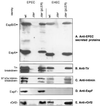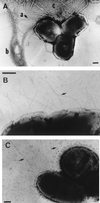The locus of enterocyte effacement (LEE)-encoded regulator controls expression of both LEE- and non-LEE-encoded virulence factors in enteropathogenic and enterohemorrhagic Escherichia coli
- PMID: 11035714
- PMCID: PMC97688
- DOI: 10.1128/IAI.68.11.6115-6126.2000
The locus of enterocyte effacement (LEE)-encoded regulator controls expression of both LEE- and non-LEE-encoded virulence factors in enteropathogenic and enterohemorrhagic Escherichia coli
Abstract
Regulation of virulence gene expression in enteropathogenic Escherichia coli (EPEC) and enterohemorrhagic E. coli (EHEC) is incompletely understood. In EPEC, the plasmid-encoded regulator Per is required for maximal expression of proteins encoded on the locus of enterocyte effacement (LEE), and a LEE-encoded regulator (Ler) is part of the Per-mediated regulatory cascade upregulating the LEE2, LEE3, and LEE4 promoters. We now report that Ler is essential for the expression of multiple LEE-located genes in both EPEC and EHEC, including those encoding the type III secretion pathway, the secreted Esp proteins, Tir, and intimin. Ler is therefore central to the process of attaching and effacing (AE) lesion formation. Ler also regulates the expression of LEE-located genes not required for AE-lesion formation, including rorf2, orf10, rorf10, orf19, and espF, indicating that Ler regulates additional virulence properties. In addition, Ler regulates the expression of proteins encoded outside the LEE that are not essential for AE lesion formation, including TagA in EHEC and EspC in EPEC. delta ler mutants of both EPEC and EHEC show altered adherence to epithelial cells and express novel fimbriae. Ler is therefore a global regulator of virulence gene expression in EPEC and EHEC.
Figures








References
-
- Bertin P, Benhabiles N, Krin E, Laurent-Winter C, Tendeng C, Turlin E, Thomas A, Danchin A, Brasseur R. The structural and functional organization of H-NS-like proteins is evolutionarily conserved in gram-negative bacteria. Mol Microbiol. 1999;31:319–329. - PubMed
-
- Bieber D, Ramer S W, Wu C Y, Murray W J, Tobe T, Fernandez R, Schoolnik G K. Type IV pili, transient bacterial aggregates, and virulence of enteropathogenic Escherichia coli. Science. 1998;280:2114–2118. - PubMed
-
- Brunder W, Schmidt H, Karch H. EspP, a novel extracellular serine protease of enterohaemorrhagic Escherichia coli O157:H7 cleaves human coagulation factor V. Mol Microbiol. 1997;24:767–778. - PubMed
Publication types
MeSH terms
Substances
Grants and funding
LinkOut - more resources
Full Text Sources
Other Literature Sources

